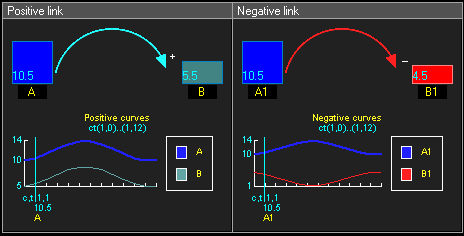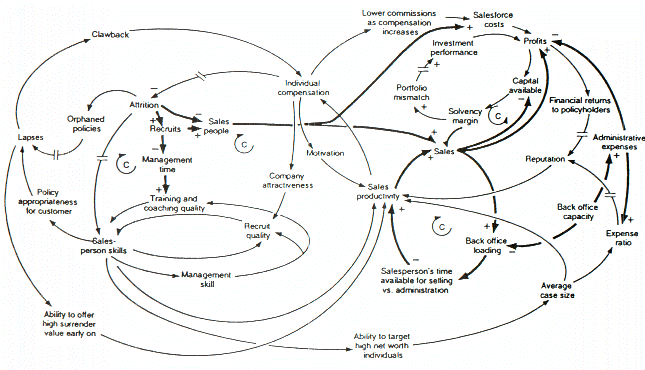
A causal loop diagram (CLD) is a causal diagram that visualizes how different variables in a system are causally interrelated. The diagram consists of a set of words and arrows. Causal loop diagrams are accompanied by a narrative which describes the causally closed situation the CLD describes. Closed loops, or causal feedback loops, in the diagram are very important features of CLDs because they may help identify non-obvious vicious circles and virtuous circles.
Contents
- History
- Positive and negative causal links
- Example
- Reinforcing and balancing loops
- Example 2
- See also
- References
- External links
The words with arrows coming in and out represent variables, or quantities whose value changes over time and the links represent a causal relationship between the two variables (i.e., they do not represent a material flow). A link marked + indicates a positive relation where an increase in the causal variable leads, all else equal, to an increase in the effect variable, or a decrease in the causal variable leads, all else equal, to a decrease in the effect variable. A link marked - indicates a negative relation where an increase in the causal variable leads, all else equal, to a decrease in the effect variable, or a decrease in the causal variable leads, all else equal, to an increase in the effect variable. A positive causal link can be said to lead to a change in the same direction, and an opposite link can be said to lead to change in the opposite direction, i.e. if the variable in which the link starts increases, the other variable decreases and vice versa.
The words without arrows are loop labels. As with the links, feedback loops have either positive (i.e., reinforcing) or negative (i.e., balancing) polarity. CLDs contain labels for these processes, often using numbering (e.g., B1 for the first balancing loop being described in a narrative, B2 for the second one, etc.), and phrases that describe the function of the loop (i.e., "haste makes waste"). A reinforcing loop is a cycle in which the effect of a variation in any variable propagates through the loop and returns to reinforce the initial deviation (i.e. if a variable increases in a reinforcing loop the effect through the cycle will return an increase to the same variable and vice versa). A balancing loop is the cycle in which the effect of a variation in any variable propagates through the loop and returns to the variable a deviation opposite to the initial one (i.e. if a variable increases in a balancing loop the effect through the cycle will return a decrease to the same variable and vice versa). Balancing loops are typically goal-seeking, or error-sensitive, processes and are presented with the variable indicating the goal of the loop. Reinforcing loops are typically vicious or virtuous cycles.
Example of positive reinforcing loop shown in the illustration:
- The amount of the
Bank Balancewill affect the amount of theEarned Interest, as represented by the top blue arrow, pointing from 'Bank BalancetoEarned Interest. - Since an increase in
Bank balanceresults in an increase inEarned Interest, this link is positive, which is denoted with a+. - The
Earned interestgets added to theBank balance, also a positive link, represented by the bottom blue arrow. - The causal effect between these variables forms a positive reinforcing loop, represented by the green arrow, which is denoted with an R. [1] (The terms positive and negative mean "tends to increase" and "tend to reduce", not subjective value judgements.)


